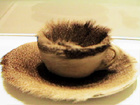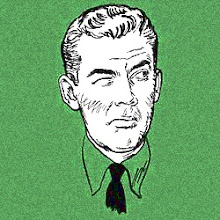
Two thousand live dramas for television were produced in the period from 1947 (the debut of NBC's
Kraft Television Theatre) to 1961 (when CBS's
Playhouse was cancelled). Two thousand! Alas (as Gary Edgerton notes) fewer than 100 of those 2000 are available in archives to be viewed and assessed by critics. We'll never know, from these works of art themselves, how the decline toward the year 1960 happened. Of course in sociological and economic terms, we know a lot about why 1960 was a crucially dismal year in TV's slide downward toward what Kennedy's FCC chief, the New Frontiersman Newton Minow (great name!), called "a vast wasteland" in his famous May 1961 speech.
Perry Mason on CBS peaked just after '60. It ran from 1957 to 1966 and was a top-20 show pretty much the whole time. In 1961-62 it reached number 5 on the charts. "The triumph of
Perry Mason," wrote Thomas Leitch, "is a triumph of formula."
1960 was the year in which TV Westerns started to fall. They had become so prominent and so much a part of TV culture that it must have been hard to believe at first that this was really happening. But it had been a brief run, really. There were sixteen Westerns in 1957-58, 24 in '58-'59, a peak of 28 in 1959-60. Then 22 in 1960-61. Ten had been in the top 30 in 1957-58, only 8 in the top 30 in 1960-61.
The Untouchables first aired on October 15, 1959.
The Twilight Zone ran from October 2, 1959 to September 18, 1964.
The Andy Griffith Show debuted in our year, on October 3, 1960 (it ran until halfway through 1968, which is simply hard for me to fathom).

And
My Three Sons also came on the air in '60: September 29, to be exact. Its fans saw 369 shows by the end (1972). It's Don Fedderson's epic family saga. A single dad, his wifeless state mostly a repressed secret. Pipe-smoke wisdom from Fred MacMurray, named--without an iota of political or historical relevance--"Steven Douglas." Or maybe a political irony: Stephen A. Douglas was of course one of the greatest orators ever, a bombast in the pre-modern mode; our 1960 Steven Douglas was a shoulder-shrugging understater of domestic punditry, a model of modest self-sacrifice for "my boys." Of course in another sense MacMurray's domesticated Douglas and our 19th-century Douglas put the same twist on the American version of Protestant capitalism: the historical Douglas advocated a democratic doctrine that emphasized equality of all citizens (of course for Douglas only whites were citizens), in which individual merit and social mobility was
not a main goal. What counted implicitly was one's natural standing and the nation's job was to make it possible for people like 1960's Steve Douglas to do what he does and remain in a position to do it, so that Mike, Robbie and Chip (and later Ernie) can grow up without becoming delinquents and freaks and the gone wife's father and later "Uncle Charlie" can continue to get free meals in the suburban manor.
Meantime, while the father's social mobility declines in importance, on January 21, 1960, the day after JFK was sworn in (new era!),
Playhouse 90 was forced to cut back from weekly to twice monthly.
On election day, November 8, 1960, there were 90 million TV sets in the U.S., nearly one for every two Americans. The Kennedy-Nixon debates were watched by 66.5 million viewers! They were the first such debates of this sort (aired on TV but--more--really made for TV) and they remain to this day the highest-rated presidential debates ever. The last debate earned a 66 rating. Note too that the viewership went up from the first to the third debate, as word got out about how exciting and important they were - not down as is usually the case. (In RatingsWorld this effect is something like what you see for the seventh game of a World Series, like Red Sox-Reds in '75. As the quality of contest itself became clear, excitement grew.)
Newton Minow (I still can't get over that name) didn't just say that TV was "a vast wasteland" when he spoken at the National Association of Broadcasters convention in Washington on May 9, 1961. Here is a little more context. He told industry executives to "sit down in front of your television set when your station goes on the air and stay there without a book, magazine, newspaper, profit-and-loss sheet or rating book to distract you--and keep your eyes glued to that set until the station signs off. I can assure you that you will observe a vast wasteland." As Gary Edgerton in
The Columbia HIstory of American Television unironically observes: "[T]he association's membership had never before heard anyone make a literary allusion to T. S. Eliot when discussing television."
 The 1960 Cadillac, on the other hand, was toned down from the '59 model. Thomas Bonsall's The Cadillac Story reports in this context that "the compact car boom was on; big and flashy were no longer 'in.'" Toned down? Big no longer in? Look at that car!
The 1960 Cadillac, on the other hand, was toned down from the '59 model. Thomas Bonsall's The Cadillac Story reports in this context that "the compact car boom was on; big and flashy were no longer 'in.'" Toned down? Big no longer in? Look at that car! But for all the talk of "the compact car boom," luxury models for 1960 still look (at least to us now) like the car of the 50s. They don't yet have that distinctive sixties look. Compare the big black machine above to the Corvette of '62, here at left. In design terms, the difference is epochal.
But for all the talk of "the compact car boom," luxury models for 1960 still look (at least to us now) like the car of the 50s. They don't yet have that distinctive sixties look. Compare the big black machine above to the Corvette of '62, here at left. In design terms, the difference is epochal. 








 Is '60 the moment when the end of the end of the Old Left had been reached and the New Left began to emerge? Is it the final ascendancy, in certain scenes at least, of poetic postmodernity? Surely the publication of Donald Allen's The New American Poetry that year suggests this, but then again--once again--we look back on "New" here and see continuity. The rhetoric of the Kennedy-Nixon contest made much less of a dent than everyone (at the time as well as since) claimed, so one wonders why were such great claims made?
Is '60 the moment when the end of the end of the Old Left had been reached and the New Left began to emerge? Is it the final ascendancy, in certain scenes at least, of poetic postmodernity? Surely the publication of Donald Allen's The New American Poetry that year suggests this, but then again--once again--we look back on "New" here and see continuity. The rhetoric of the Kennedy-Nixon contest made much less of a dent than everyone (at the time as well as since) claimed, so one wonders why were such great claims made?  Had we come to expect "1960" to be truly ubiquitously modern in a way that the 1950s really were not--not quite? And what specifically does "modern" mean in the Kennedyesque talk then and now about the torch being passed to a new generation, etc.? The First Lady really meant "modernist" when Camelotians said "modern." What about the others across the new young cultural leadership? I've been surprised by how frequently the
Had we come to expect "1960" to be truly ubiquitously modern in a way that the 1950s really were not--not quite? And what specifically does "modern" mean in the Kennedyesque talk then and now about the torch being passed to a new generation, etc.? The First Lady really meant "modernist" when Camelotians said "modern." What about the others across the new young cultural leadership? I've been surprised by how frequently the  "Beat movement" was covered in 1960 in the mainstream press. I was expecting a fair measure but I've found tonnage. 1960 was the year when the figure of the beat was beginning to find acceptance, although still 80% of these stories are mocking, rebels-without-cause condescension. For anyone whose analysis made an impact nationally, do these antipolitical adolescents count as part of the "new young cultural leadership"? No, but rather than the two being opposites, they fall along a Continuum of the New American. Now that's a change for '60.
"Beat movement" was covered in 1960 in the mainstream press. I was expecting a fair measure but I've found tonnage. 1960 was the year when the figure of the beat was beginning to find acceptance, although still 80% of these stories are mocking, rebels-without-cause condescension. For anyone whose analysis made an impact nationally, do these antipolitical adolescents count as part of the "new young cultural leadership"? No, but rather than the two being opposites, they fall along a Continuum of the New American. Now that's a change for '60.







